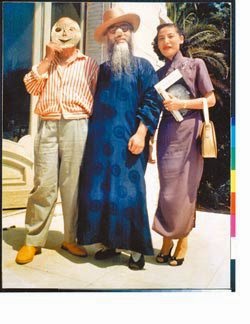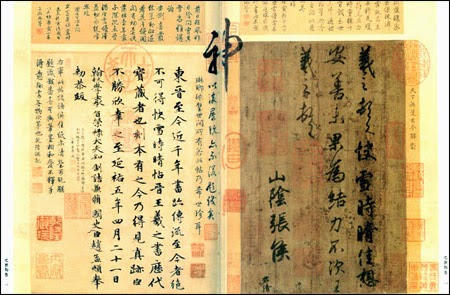聲明: 我不是中國書法專家。我只是個中國書法業餘愛好者。歡迎各位的批評和指教。
A master calligrapher makes his craft look effortless. It takes only 5-10 minutes to write 10 to 100 characters, but masterpieces are treasured and save for millennia.
書法工藝外觀看來不費絲毫力氣。寫出幾十百字只要幾分鐘,但被視為佳作就能珍藏幾千年。
I have tried a few times writing calligraphy, and it requires hand and mind to flow as one. I don't say this in a artsy or flowery sense, any doubts or wanderings of the mind literally translates to the hands. The slightest twitch can ruin a masterpiece.
我自己只試過毛筆幾次而已。書法需要手於心靈相通。我說的不是藝術氣息或華麗感,而是心裡的一絲懷疑就會影響到手的動作。手的細微抖動能毀掉傑作。
I'm not going to start the discussion of Chinese calligraphy in chronological order with oracle bones from the Shang Dynasty. I will start with the most familiar.
首先,我不按時間順序從商朝甲骨文談起書法的字體演變。我先講各位比較熟悉的。
The most commonly used script that's still used in practice today is called "Kaishu"(楷書). Calligraphy taught in the Far East teaches Kaishu first in standard public education. While American schools used #2 carbon pencils to write between comically large lines, Chinese students jump into the deep end of the pool and use the same tools as calligraphy masters. The four basic tools are called "The Four Treasures of the Study Room" (書房四寶), they include the paper, paperweight, brush, and ink. Albeit, beginners get to use grid paper like this:
現在最常用的字體是楷書。 東亞地區教書法先用楷書做標準字體。而美國用二號鉛筆碳寫字在滑稽的大線裡面,中國學生跳進池深側而用書法大師的工具。 基本工具稱為“書房四寶”, 它們包括筆,墨,紙, 硯。 儘管,學徒用九宮格紙:
(Source)
要成為書法家都從擬摹以前的名家著手。但抄寫如何稱為一種藝術? 書法沒有原創的話, 這種藝術形式真實傳達創作者的意念?
I respond with the master mimicker, Zhang Daqian 1899 - 1983 (張大千):
我舉模仿大師,張大千1899 - 1983:
(Source. I hope I age as gracefully as him when I'm old)
Zhang Daqian was known mostly for his Chinese painting, but the brush techniques in painting derive from writing characters. Although his works are fairly contemporary to the time scale of Chinese history, he was able to re-discover painting techniques lost for 1300 years when he studied the Dunhuang caves. Even today, some paintings that were originally thought to date from the Tang may have been Zhang Daqian's works. That's like someone during the Great Depression painting Da Vinci fooling professional historians today! Except the forgeries of Zhang Daqian were older than Da Vinci by another 500 years! It was his ability to mimic that helped rediscover the techniques of ancient painting.
張大千的作品多為中國繪畫,但繪畫技術啟發自書法。雖然他的作品表現了當代中國歷史的時間尺度,但當他研究敦煌石窟時期, 他重新發現失落了1300年的粉刷技術。即使在現在,有些繪畫原先以為可上溯唐朝,事實上卻可能是張大千的作品。這就像大蕭條時期的達文西的繪畫愚弄了今日的專業歷史學家! 但張大千的贗品比達文西通過年長另外500 年! 他的模仿能力幫助世人重新發現古代繪畫的技巧。
(Even the color pigments Zhang used were authentic to the Tang Dynasty! The colors dude, the colors!)

(Source. East and West meet! Starting from left to right: Pablo Picasso, Zhang Daqian, Xu Wenbo (Zhang Daqian's 4th wife))
複製的行為還保留了書法及其對人們長期的影響。試想一下,如果有貝奧武甫的一個秘密的原件被保存,和每一個主要的文學和歷史人物決定閱讀欣賞的佳作後附加一個自己的評論。比方說,喬叟,約翰國王,莎士比亞,英國國王愛德華二世,濟慈,阿奎那,狄更斯和喬治華盛頓都寫了些什麼。英語專業的學生將建立一個大教堂和有興奮地崇拜這個文件。中國文學文化的存在一份名為 “快雪時晴帖”的書札王羲之(公元303至公元361 )。
The entire scroll is much longer. Here's the full version. The right side with the blackened paper is Wang Xizhi's original calligraphy. It's only four lines of poetry, 28 characters. So what does Wang Xizhi have to do with Chinese calligraphy? Wait for part II!
整個捲軸更長。下面是完整版本。右側的熏黑紙是王羲之的書法原創。它只有四行詩, 28個字符。那麼,王羲之與中國書法有什麼關係呢?等待第二部分!
Feel free to leave a message for requests on future blog topics.
隨意留言給未來的博客主題的請求。







